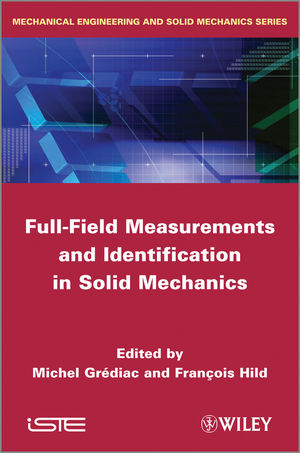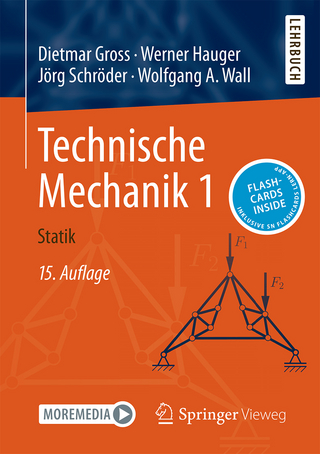
Full-Field Measurements and Identification in Solid Mechanics
ISTE Ltd and John Wiley & Sons Inc (Verlag)
9781848212947 (ISBN)
- Titel z.Zt. nicht lieferbar
- Versandkostenfrei
- Auch auf Rechnung
- Artikel merken
This timely book presents cutting-edge developments by experts in the field on the rapidly developing and scientifically challenging area of full-field measurement techniques used in solid mechanics – including photoelasticity, grid methods, deflectometry, holography, speckle interferometry and digital image correlation. The evaluation of strains and the use of the measurements in subsequent parameter identification techniques to determine material properties are also presented.
Since parametric identification techniques require a close coupling of theoretical models and experimental measurements, the book focuses on specific modeling approaches that include finite element model updating, the equilibrium gap method, constitutive equation gap method, virtual field method and reciprocity gap method. In the latter part of the book, the authors discuss two particular applications of selected methods that are of special interest to many investigators: the analysis of localized phenomenon and connections between microstructure and constitutive laws. The final chapter highlights infrared measurements and their use in the mechanics of materials.
Written and edited by knowledgeable scientists, experts in their fields, this book will be a valuable resource for all students, faculties and scientists seeking to expand their understanding of an important, growing research area
Dr. Michel Grédiac received an M.S. degree in mechanical engineering from the "Ecole Nationale Supérieure d'Arts et Métiers" in Paris and a Ph.D. degree in mechanical engineering from the University of Lyon in 1991. He was appointed as research professor at the Ecole Nationale Supérieure des Mines de Saint-Etienne and promoted to full professor at the University of Clermont-Ferrand in 1997. In 2003, Dr. Michel Grédiac founded a network named "Full-field measurements and identification in solid mechanics" gathering 25 French research groups devoted to the development and the use of full-field measurement techniques in experimental solids mechanics. He was the head of this network till 2010. Dr. François Hild graduated from École Normale Supérieure de Cachan in 1989. He received his Ph.D. in mechanical engineering from the University of Paris 6 in 1992, and from the University of California in 1995. He received his habilitation from the University of Paris 6 in 1998. Since 2003, he is a Research Professor at the Laboratory of Mechanics and Technology in Cachan (France), and is the current head of the Mechanics and Materials division.
Foreword xv
Michael A. SUTTON
Introduction xvii
Michel GRÉDIAC and François HILD
Chapter 1. Basics of Metrology and Introduction to Techniques 1
André CHRYSOCHOOS and Yves SURREL
1.1. Introduction 1
1.2. Terminology: international vocabulary of metrology 2
1.2.1. Absolute or differential measurement 2
1.2.2. Main concepts 4
1.3. Spatial aspect 11
1.3.1. Spatial frequency 11
1.3.2. Spatial filtering 16
1.4. Classification of optical measurement techniques 18
1.4.1. White light measurement methods 19
1.4.2. Interference methods 21
1.4.3. Sensitivity vector 23
1.4.4. Synthetic sensitivity vectors 23
1.4.5. The different types of interferometric measurements 24
1.4.6. Holography, digital holography 27
1.4.7. Conclusion 28
1.5. Bibliography 29
Chapter 2. Photoelasticity 31
Fabrice BRÉMAND and Jean-Christophe DUPRÉ
2.1. Introduction 31
2.2. Concept of light polarization 32
2.3. Birefringence phenomenon 33
2.4. The law of optico-mechanics 34
2.5. Several types of polariscopes 35
2.5.1. Plane polariscope 35
2.5.2. Circular polariscope 38
2.5.3. White light polariscope 40
2.5.4. Photoelastic coating 40
2.6. Measurement of photoelastic constant C 42
2.7. Analysis by image processing 43
2.7.1. Using a plane polariscope 43
2.7.2. Using a circular polariscope 47
2.7.3. Using color images 48
2.8. Post-processing of photoelastic parameters 48
2.8.1. Drawing of isostatics or stress trajectories 48
2.8.2. Particular points 48
2.8.3. Stress separation and integration of the equilibrium equations 49
2.8.4. Comparison between experimentation and numerical modeling 50
2.9. Three-dimensional photoelasticity 50
2.9.1. The method of stress freezing and mechanical slicing 51
2.9.2. Optical slicing 52
2.9.3. Application example 56
2.10. Conclusion 57
2.11. Bibliography 57
Chapter 3. Grid Method, Moiré and Deflectometry 61
Jérôme MOLIMARD and Yves SURREL
3.1. Introduction 61
3.2. Principle 61
3.3. Surface encoding 63
3.4. Moiré 64
3.5. Phase detection 66
3.5.1. Global extraction procedure 66
3.5.2. Local phase detection: phase shifting 67
3.5.3. Measuring both components of the displacement 70
3.6. Sensitivity to out-of-plane displacements 71
3.7. Grid defects 72
3.8. Large deformation/large strain 73
3.8.1. Explicit method 73
3.8.2. Implicit method 74
3.8.3. Large strain 74
3.9. Fringe projection 75
3.10. Deflectometry 78
3.11. Examples 81
3.11.1. Off-axis tensile test of a unidirectional composite coupon 81
3.11.2. Rigid body displacement 83
3.11.3. SEM measurement 84
3.11.4. Characterization of lens distortion 85
3.12. Conclusion 88
3.13. Bibliography 89
Chapter 4. Digital Holography Methods 93
Pascal PICART and Paul SMIGIELSKI
4.1. Introduction 93
4.2. Basics of wave optics 94
4.2.1. Light diffraction 95
4.2.2. Interference 96
4.3. Basics of digital holography 97
4.3.1. Recording the hologram 97
4.3.2. Numerical reconstruction with the discrete Fresnel transform 99
4.3.3. Numerical reconstruction using convolution with adjustable magnification 100
4.3.4. Sensitivity vector 101
4.4. Basics of digital holographic interferometry 103
4.4.1. Phase difference 103
4.4.2. Spatial filtering of the phase and phase unwrapping 104
4.5. Digital holographic interferometry with spatial multiplexing 104
4.5.1. Principle 104
4.5.2. Theory 105
4.5.3. Experimental set-up 105
4.5.4. Application to synthetic concrete subjected to three-point bending 107
4.6. Digital color holography applied to three-dimensional measurements 112
4.6.1. Recording digital color holograms 112
4.6.2. Application to composite material subjected to a short beam test 113
4.7. Conclusion 118
4.8. Acknowledgment 119
4.9. Bibliography 119
Chapter 5. Elementary Speckle Interferometry 125
Pierre JACQUOT, Pierre SLANGEN and Dan BORZA
5.1. Introduction 125
5.2. What is speckle interferometry? 126
5.2.1. Simplified principle – correlation fringes 128
5.2.2. Speckle field and specklegram statistics in a nutshell 129
5.2.3. Speckle field transformation – small perturbation theory 131
5.2.4. Phase change-deformation law – sensitivity vector 132
5.2.5. Success or failure of experiments – central role of decorrelation 133
5.3. Optical point of view 134
5.4. Mechanical point of view: specific displacement field components 136
5.4.1. Measurement of the out-of-plane component 136
5.4.2. Measurement of the in-plane component [LEE 70] 137
5.4.3. 3C-3D: three components attached to three-dimensional objects 138
5.4.4. Partial derivatives of the displacement – shearography 139
5.4.5. Shape measurement and other considerations 140
5.5. Phase extraction 141
5.5.1. One-image methods 141
5.5.2. Phase-shifting methods 142
5.5.3. Advanced methods 143
5.5.4. Phase unwrapping 144
5.6. Dynamic deformations and vibrations 46
5.7. Setup calibration 148
5.7.1. Specifying the material point in object coordinates 149
5.7.2. Determination of the sensitivity vector 149
5.8. Specifications and limits 150
5.9. Final remarks, outlook and trends 151
5.10. Bibliography 153
Chapter 6. Digital Image Correlation 157
Michel BORNERT, François HILD, Jean-José ORTEU and Stéphane ROUX
6.1. Background 157
6.2. Surface and volume digital image correlation 158
6.2.1. Images 158
6.2.2. Texture of images 159
6.2.3. Guiding principles 161
6.2.4. Correlation coefficients 163
6.2.5. Subpixel interpolation 164
6.2.6. Local approaches 166
6.2.7. Optimization algorithms 168
6.2.8. Global approaches 169
6.3. Errors and uncertainties 172
6.3.1. Main error sources 172
6.3.2. Uncertainty and spatial resolution 173
6.3.3. Noise sensitivity 174
6.4. Stereo-correlation or 3D-DIC 175
6.4.1. The stereovision technique 176
6.4.2. 3D displacement measurement by stereo-correlation 180
6.4.3. Computation of surface strains from 3D displacements 181
6.4.4. Applications 182
6.5. Conclusions 182
6.6. Bibliography 183
Chapter 7. From Displacement to Strain 191
Pierre FEISSEL
7.1. Introduction 191
7.2. From measurement to strain 191
7.2.1. Three related steps 191
7.2.2. Framework for the differentiation of displacement measurements 192
7.2.3. The main families of methods for differentiating data 194
7.2.4. Quality of the reconstruction 195
7.3. Differentiation: difficulties illustrated for a one-dimensional example 197
7.3.1. A simple one-dimensional example 197
7.3.2. Finite differences 198
7.3.3. Global least squares – polynomial basis 199
7.3.4. Filtering through a convolution kernel 200
7.4. Approximation methods 203
7.4.1. General presentation 203
7.4.2. Global least squares – Finite element basis 204
7.4.3. Local least squares – polynomial basis 206
7.4.4. Three converging points of view 207
7.5. Behavior of the reconstruction methods 209
7.5.1. Splitting the reconstruction error 209
7.5.2. Estimation of approximation error 210
7.5.3. Estimation of random error 211
7.6. Selection criterion for the filtering parameters 214
7.6.1. Constant signal-to-noise ratio 214
7.6.2. A pragmatic criterion 216
7.7. Taking the time dimension into consideration 218
7.8. Concluding remarks 220
7.9. Bibliography 220
Chapter 8. Introduction to Identification Methods 223
Marc BONNET
8.1. Introduction 223
8.2. Identification and inversion: a conceptual overview 223
8.2.1. Inversion 223
8.2.2. Constitutive parameter identification 230
8.3. Numerical methods based on optimization 232
8.3.1. Gradient-based methods 232
8.3.2. Other methods 236
8.4. Methods specifically designed for full-field measurements: an overview 237
8.4.1. Finite element model updating 237
8.4.2. Constitutive relation error 238
8.4.3. Methods based on equilibrium satisfaction 239
8.4.4. Reciprocity gap 241
8.5. Conclusion 242
8.6. Bibliography 242
Chapter 9. Parameter Identification from Mechanical Field Measurements using Finite Element Model Updating Strategies 247
Emmanuel PAGNACCO, Anne-Sophie CARO-BRETELLE and Patrick IENNY
9.1. Introduction 247
9.2. Finite element method 249
9.2.1. Principles of the method 249
9.2.2. The “direct mechanical problem” and finite element analysis 252
9.3. Updating a finite element model for parameter identification 254
9.3.1. Theory 254
9.3.2. Objective functions and minimization procedure 256
9.3.3. Structural sensitivities 262
9.4. Applications, results and accuracy 264
9.4.1. Full-field measurements for the FEMU method 264
9.4.2. Application to the material behavior 265
9.4.3. Identification accuracy 267
9.5. Conclusion 268
9.6. Bibliography 269
Chapter 10. Constitutive Equation Gap 275
Stéphane PAGANO and Marc BONNET
10.1. Introduction 275
10.2. CEG in the linear elastic case: heterogeneous behavior and full-field measurement 276
10.2.1. First variant: exact enforcement of kinematic measurements 278
10.2.2. Second variant: enforcement of measurements by kinematic penalization 283
10.2.3. Comments 283
10.2.4. Some numerical examples 284
10.3. Extension to elastoplasticity 288
10.3.1. Formulation 288
10.3.2. Numerical method 290
10.4. Formulations based on the Legendre–Fenchel transform 293
10.5. Suitable formulations for dynamics or vibration 295
10.6. Conclusions 297
10.7. Bibliography 298
Chapter 11. The Virtual Fields Method 301
Michel GRÉDIAC, Fabrice PIERRON, Stéphane AVRIL, Evelyne TOUSSAINT and Marco ROSSI
11.1. Introduction 301
11.2. General principle 301
11.3. Constitutive equations depending linearly on the parameters: determination of the virtual fields 303
11.3.1. Introduction 303
11.3.2. Developing the PVW 303
11.3.3. Special virtual fields 305
11.3.4. Virtual fields optimized with respect to measurement noise 307
11.3.5. Virtual fields defined by subdomains 309
11.3.6. Examples 311
11.3.7. Plate bending 313
11.3.8. Large deformations: example of hyperelasticity 319
11.4. Case of constitutive equations that do not linearly depend on the constitutive parameters 321
11.4.1. Introduction 321
11.4.2. Elastoplasticity 321
11.4.3. Hyperelastic behavior 324
11.5. Conclusion 325
11.6. Bibliography 326
Chapter 12. Equilibrium Gap Method 331
Fabien AMIOT, Jean-Noël PÉRIÉ and Stéphane ROUX
12.1. Theoretical basis 331
12.1.1. Homogeneous elastic medium 332
12.1.2. Heterogeneous elastic medium 334
12.1.3. Incremental formulation 334
12.2. Finite difference implementation 335
12.3. Finite element implementation 337
12.4. Application to beam theory: local buckling 340
12.4.1. Application to beam theory 340
12.4.2. Loading identification 342
12.4.3. Identification of a heterogeneous stiffness field 343
12.5. Simultaneous identification of stiffness and loading fields 345
12.6. Spectral sensitivity and reconditioning 347
12.7. Damage 349
12.8. Application to a biaxial test carried out on a composite material 351
12.8.1. Damage modeling 352
12.8.2. Adapted expression of the reconditioned equilibrium gap 354
12.8.3. Application to a biaxial test 355
12.9. Exploitation of measurement uncertainty 358
12.10. Conclusions 359
12.11. Bibliography 360
Chapter 13. Reciprocity Gap Method 363
Stéphane ANDRIEUX, Huy Duong BUI and Andrei CONSTANTINESCU
13.1. Introduction 363
13.2. The reciprocity gap method 365
13.2.1. Definition of the reciprocity gap 367
13.2.2. Fundamental property of the reciprocity gap 367
13.3. Identification of cracks in electrostatics 368
13.3.1. Identification formulas for the plane of the crack(s) 370
13.3.2. Complete identification of cracks 371
13.4. Crack identification in thermoelasticity using displacement measurements 373
13.5. Conclusions and perspectives 377
13.6. Bibliography 378
Chapter 14. Characterization of Localized Phenomena 379
Jacques DESRUES and Julien RÉTHORÉ
14.1. Introduction 379
14.2. Definitions and properties of the localized phenomena being considered 380
14.3. Available methods for the experimental characterization of localized phenomena 386
14.3.1. Direct observation 386
14.3.2. Recording the coordinates of predefined markers 387
14.3.3. False relief photogrammetry 387
14.3.4. Digital image correlation 387
14.3.5. Digital volume correlation 388
14.3.6. X-ray tomography 388
14.4. Localization kinematics: a case study 390
14.4.1. Emergence and development of shear bands in a sand specimen under plane strain revealed by stereophotogrammetry 390
14.4.2. Comparison of stereophotogrammetry and digital image correlation for a biaxial test of a soft clay-rock specimen 391
14.4.3. The contribution of digital volume correlation to the detection of localization in isochoric shearing 393
14.4.4. Characterization of severe discontinuities: stereophotogrammetry and correlation 393
14.4.5. Localization on the grain scale: the contribution of discrete DVC 394
14.4.6. A fatigue crack in steel 395
14.4.7. Piobert–Lüders band in steel 395
14.4.8. Portevin–Le Châtelier band 396
14.5. The use of enriched kinematics 397
14.5.1. Displacement discontinuity 398
14.5.2. Strain discontinuity 399
14.6. Localization of the discontinuity zone 399
14.6.1. The use of strain fields 400
14.6.2. The use of correlation residuals 400
14.7. Identification of fracture parameters 401
14.8. Conclusion 405
14.9. Bibliography 406
Chapter 15. From Microstructure to Constitutive Laws 411
Jérôme CRÉPIN and Stéphane ROUX
15.1. Introduction 411
15.2. General problem 411
15.2.1. How can we appreciate spatial heterogeneity? 411
15.2.2. Phase segmentation 413
15.2.3. Inverse problem 413
15.2.4. Statistical description/morphological model 414
15.2.5. Coupling of identification with an exogenous field 417
15.3. Examples of local field characterization 418
15.3.1. EBSD analysis and orientation imaging microscopy 419
15.4. First example: elastic medium with microstructure 423
15.4.1. Glass wool 423
15.4.2. Identification 426
15.5. Second example: crystal plasticity 427
15.5.1. Multiscale approach for identification of material mechanical behavior 428
15.5.2. Methodology 430
15.5.3. Numerical simulation of mechanical behavior 431
15.6. Conclusions 434
15.7. Bibliography 435
Chapter 16. Thermographic Analysis of Material Behavior 439
Jean-Christophe BATSALE, André CHRYSOCHOOS, Hervé PRON and Bertrand WATTRISSE
16.1. Introduction 439
16.2. Thermomechanical framework 441
16.2.1. Constitutive equations 441
16.2.2. Heat equation 443
16.2.3. Energy balance over a load-unload cycle 444
16.3. Metrological considerations 446
16.3.1. Physics of radiation preliminaries 447
16.3.2. Calibration 448
16.3.3. Thermal noise and thermal drift 452
16.4. Heat diffusion models and identification methods 454
16.4.1. Diffusion equation for thin plates 454
16.4.2. Diffusion equation for straight beams 455
16.4.3. Diffusion equation for a monotherm material volume element 456
16.4.4. Integral transforms and quadrupole method related to thick media 457
16.5. Concluding comments and prospects 463
16.6. Bibliography 464
List of Authors 469
Index 475
| Verlagsort | London |
|---|---|
| Sprache | englisch |
| Maße | 163 x 241 mm |
| Gewicht | 871 g |
| Themenwelt | Naturwissenschaften ► Physik / Astronomie ► Mechanik |
| Technik ► Maschinenbau | |
| ISBN-13 | 9781848212947 / 9781848212947 |
| Zustand | Neuware |
| Informationen gemäß Produktsicherheitsverordnung (GPSR) | |
| Haben Sie eine Frage zum Produkt? |
aus dem Bereich


